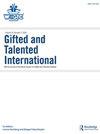Exploring differences in creativity across academic majors for high-ability college students
Q3 Social Sciences
引用次数: 6
Abstract
ABSTRACT Many current theories and models include creativity as a component of giftedness, conceptualizing the construct in numerous ways that complement giftedness. Variations in creativity have also been studied among different academic disciplines, suggesting that although there may be higher levels of creativity for some, major choice is a complex concept. The current study explores differences in several aspects of creativity based on academic major for a high-ability young adult population. Using data from 399 Honors College students at a Midwestern university in the United States, a MANOVA and series of 1-way ANOVAs suggest significant differences by academic major for creative engagement, creative cognitive style, and fantasy, but not for tolerance or spontaneity. The pattern of results generally indicates higher creativity among arts and humanities majors, compared with other disciplines such as education and pre-professional training, although these fields can also benefit from creative input. Potential curricular and experiential reasons for these differences are discussed, along with some implications for educational programming and interventions.探究高能力大学生不同专业创造力的差异
许多当前的理论和模型都将创造力作为天赋的一个组成部分,并以多种方式将其概念化,以补充天赋。创造力的差异也在不同的学科中被研究过,这表明尽管有些人的创造力水平可能更高,但专业选择是一个复杂的概念。本研究探讨了高能力青年群体在不同专业的创造力方面的差异。利用来自美国中西部一所大学的399名荣誉学院学生的数据,方差分析和一系列单因素方差分析表明,不同专业在创造性投入、创造性认知风格和幻想方面存在显著差异,但在容忍度和自发性方面没有显著差异。结果的模式通常表明,与教育和职前培训等其他学科相比,艺术和人文专业的学生具有更高的创造力,尽管这些领域也可以从创造性投入中受益。讨论了这些差异的潜在课程和经验原因,以及对教育规划和干预的一些影响。
本文章由计算机程序翻译,如有差异,请以英文原文为准。
求助全文
约1分钟内获得全文
求助全文

 求助内容:
求助内容: 应助结果提醒方式:
应助结果提醒方式:


